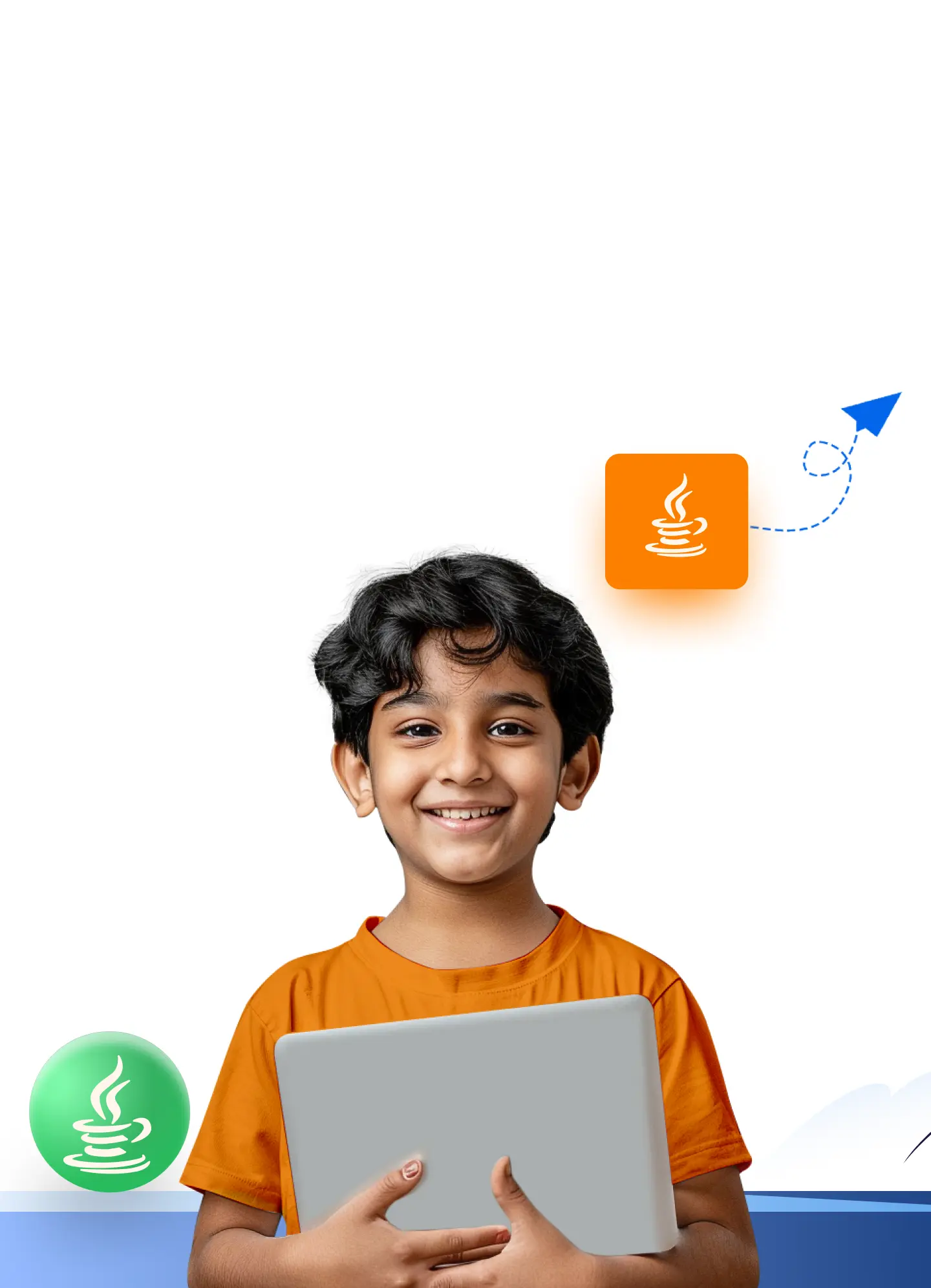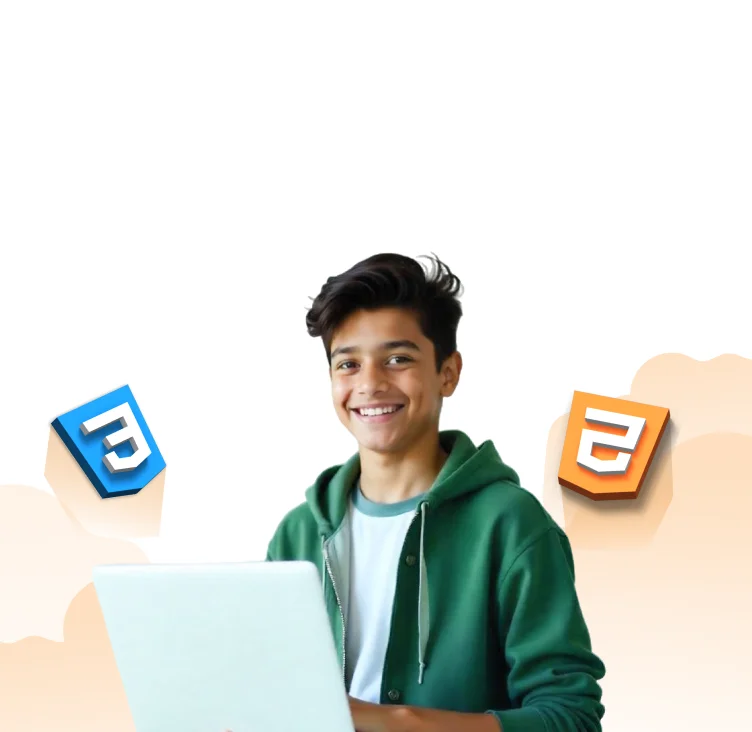Computer Science Course for Kids to Build a Strong Foundation
By Srinithi SankarIs your child spending hours on a screen, but not learning anything meaningful? In a world dominated by technology, knowing how things work behind the screen is just as important as using them. That’s where a computer science course for kids can make all the difference.
Research indicates that engaging in educational digital activities like coding can enhance children’s cognitive development. These activities promote problem-solving and critical thinking skills essential for academic success and future career readiness. By learning to code, children not only become proficient with technology but also develop the ability to think logically and creatively.
Computer science isn’t just about typing lines of code—it’s about teaching kids how to think logically, solve problems, and build their digital creations. From designing simple games to controlling robots, kids can unlock endless possibilities while building skills that last a lifetime.
In this blog, we’ll explore what a computer science course for kids looks like, why it’s so valuable to start early, and how you can choose the right course to give your child a solid, exciting, and future-ready foundation.
What is Computer Science for Kids?
Think of computer science for kids as a way to teach logic, creativity, and problem-solving—all without turning it into a dry textbook lesson. It’s not about overwhelming them with jargon or formulas. Instead, it’s about tapping into their natural curiosity, which makes them wonder how video games work or how Alexa knows their favourite song.
At its core, computer science for kids introduces concepts like coding, algorithms, patterns, and digital thinking in fun, age-appropriate ways. Through colourful blocks, interactive games, or even beginner-friendly coding languages like Python or Scratch, children learn how to build their own stories, animations, apps, or games, making tech something they can create with, not just consume.
And if your child is on summer break and you’re wondering how to make their free time more meaningful, a computer science course can be the perfect place to start. And with so many kid-centric courses available today, from visual programming to robotics and AI, it’s easier than ever to find a program that speaks your child’s language. It keeps them engaged, gives their screen time a purpose, and sets them on a path that builds real skills—without ever feeling like “school.”
The Importance of Early Computer Science Education
Introducing computer science at a young age isn’t just a fun way to pass time—it’s an investment in how your child thinks, learns, and creates. Here’s why starting early really matters:
- Boosts Academic Performance
Kids who engage in computer science early often show better outcomes in subjects like math, science, and even reading. Why? Because coding teaches them to follow logic, spot patterns, and apply structured thinking—all skills that naturally cross over into academics.
A study by Code.org found that students who study computer science perform better in core subjects and are 17% more likely to attend college.
- Builds Stronger Logical Thinking and Problem-Solving
When kids write code, they’re not just telling a computer what to do—they’re learning to break problems into steps and test solutions. It’s like building a mental muscle for thinking, solving puzzles, and approaching challenges with confidence. - Prepares Them for a Future-Focused World
From healthcare to space tech, every industry is becoming more digital. Early exposure to computer science helps kids become familiar with the tools and thinking they’ll need in tomorrow’s careers. It doesn’t mean they need to become programmers—it means they’ll be comfortable around technology, no matter the path they choose. - Turns Them into Creators, Not Just Consumers
Instead of just playing games or scrolling through content, learning computer science empowers kids to build their digital worlds. They go from saying “I wish this existed” to making it happen, with code. - Builds Lifelong Adaptability
Technology will keep evolving, but the ability to think computationally will always stay relevant. Kids who start early learn how to adapt, learn new tools faster, and stay curious as tech changes. That’s a huge advantage in both life and work.
How to Choose the Right Computer Science Course for Your Child
With so many courses out there, picking the right one can feel like a big task. But really, it comes down to understanding your child’s learning style, interests, and what will keep them engaged. Here’s what to keep in mind:
- Match it to their age and curiosity
A younger child might enjoy a more visual, story-driven experience, while an older one may be ready to explore text-based languages. Choose a course that speaks to where they are, not just what they “should” know. - Look for interactive, gamified learning
If it feels like a game, kids are more likely to stick with it. Courses that use challenges, missions, or playful design make learning feel less like a chore and more like an adventure. - Hands-on projects make all the difference
The best courses give kids something to create—whether it’s a mini-game, animation, or simple app. When they build something, the learning sticks and their confidence grows. - Concepts should build gradually
Good courses don’t rush. They introduce ideas step-by-step, layering complexity in a way that feels natural. This helps kids stay motivated, not overwhelmed. - Check for parental visibility and flexibility
You don’t need to be tech-savvy, but it’s helpful to know how your child is progressing. Look for courses that offer progress tracking or weekly summaries, and that allow kids to learn at their own pace. - Balance fun with fundamentals
It’s great if a course is fun, but it should also teach real, transferable skills. Aim for one that’s playful, yes, but still grounded in the core concepts of computer science.
Top Computer Science Courses for Kids
Explore the best beginner-friendly courses designed to spark your child’s interest in coding, problem-solving, and digital creativity.
Quick Courses by HackerKID
HackerKID’s Quick Courses offer a compact yet engaging way for kids to explore essential tech skills like Python, JavaScript, and IoT. Each course is designed to be completed in 12 hours, with hands-on lessons and interactive coding. These are also available as part of a bundled plan that includes one-year access to the full HackerKID platform.
1. Python Quick Course – HackerKID

This beginner-friendly course introduces kids to Python in a way that’s fun, accessible, and completely hands-on. Through lightweight, bite-sized tutorials, children learn how to write code, understand logic, and apply core programming concepts—without feeling overwhelmed. From variables and loops to functions and imports, every topic is broken down to help young minds grasp real-world programming through play. Perfect for kids who are new to coding and eager to explore how technology works from the inside out.
- Features: Interactive coding console, gamified lessons, immediate feedback
- Ideal Age: 8–14
- Level of Difficulty: Beginner
- Learning Format: Self-paced online
- Project-Based Learning: Yes
- Duration: 12 hours
- Certification: Yes
- Price: ₹1,299
- Free Demo: Yes, available to book on the course page
2. JavaScript Quick Course – HackerKID

Perfect for kids curious about how websites and games work, this JavaScript course offers a playful yet practical intro to one of the most popular programming languages in the world. Through interactive tutorials, children learn how to build dynamic content using real JavaScript logic—think loops, arrays, variables, and functions. It’s a hands-on experience that gently walks learners through the basics of web development in a way that’s fun, structured, and beginner-friendly.
- Features: Interactive coding console, gamified lessons, immediate feedback
- Ideal Age: 8–14
- Level of Difficulty: Beginner
- Learning Format: Self-paced online
- Project-Based Learning: Yes
- Duration: 12 hours
- Certification: Yes
- Price: ₹1,299 (or ₹8,999 bundled with 1-year HackerKID Premium access)
- Free Demo: Yes, available to book on the course page
3. IoT with Robotics Quick Course – HackerKID

This course is perfect for kids who are fascinated by gadgets, sensors, and how real-world devices respond to code. With a fun, hands-on approach, children learn how to program IoT-enabled tools like step counters, light sensors, and even door alarms using Micro: bit. Through creative builds like jukeboxes, emotional badges, and thermometers, this course introduces the exciting connection between software and hardware, all at a beginner level. It’s ideal for kids who love experimenting and making things come alive.
- Features: Interactive tutorials, sensor-based coding, gamified structure
- Ideal Age: 9–15
- Level of Difficulty: Beginner
- Learning Format: Self-paced online
- Project-Based Learning: Yes
- Duration: 12 hours
- Certification: Yes
- Price: ₹1,299 (or ₹8,999 bundled with 1-year HackerKID Premium access)
- Free Demo: Yes, available to book on the course page
4. Fundamental Courses by HackerKID
For kids ready to dive deeper into computer science, HackerKID’s Fundamental Courses offer an in-depth, structured learning experience. Covering core areas like Python, Java, JavaScript, GenAI, Computer Literacy, and IoT with Robotics, these courses are ideal for learners who want to build a stronger grasp of real-world technologies. Each course includes hands-on projects, detailed modules, and long-term learning tracks—bundled with full-year access to HackerKID’s platform, coding games, and resources. Courses start at ₹14,999 and are designed to support both conceptual mastery and creative exploration.
5. Computer Literacy Fundamentals – HackerKID

This course is a perfect starting point for young learners stepping into the world of computer science. It covers the absolute basics—what a computer is, how it works, and how to use essential tools like MS Word, Excel, PowerPoint, and even MS Paint. Kids also learn about internet use, communication, memory, and file management. It’s designed to build digital confidence in a practical, age-appropriate way and forms a strong base for all future tech learning.
- Features: Structured modules, interactive tools, real-world applications
- Ideal Age: 7–13
- Level of Difficulty: Beginner
- Learning Format: Self-paced online
- Project-Based Learning: Yes
- Duration: 25 hours
- Certification: Yes
- Price: Varies by plan
- Free Demo: Yes, available to book on the course page
6. GenAI Fundamentals – HackerKID

Designed for curious young minds ready to explore the future of technology, this course introduces kids to the world of Generative AI in a simple, interactive way. They’ll learn what AI is, how it works, and how tools like ChatGPT, Google Bard, and DALL·E create text and images. Through hands-on projects, kids explore core topics like machine learning, prompt engineering, and natural language processing—all broken down into kid-friendly modules. It’s an ideal course for children who want to create, not just consume, with AI.
- Features: Hands-on tutorials, prompt-based creation, real-world AI tools
- Ideal Age: 10–15
- Level of Difficulty: Beginner to Intermediate
- Learning Format: Self-paced online
- Project-Based Learning: Yes
- Duration: 25 hours
- Certification: Yes
- Price: Varies by course plan
- Free Demo: Yes, available to book on the course page
7. Java Fundamentals – HackerKID

This course introduces kids to one of the most widely used programming languages in the world. With a balance of theory and hands-on activities, learners dive into Java basics—syntax, loops, conditional statements, operators, and more. Whether they’re creating patterns or exploring logic through series and functions, students gain a clear understanding of Java’s object-oriented approach in a friendly, beginner-accessible format. It’s an excellent stepping stone for building powerful applications and real-world problem-solving skills.
- Features: Concept-driven tutorials, real-world applications, beginner-friendly pace
- Ideal Age: 10–16
- Level of Difficulty: Beginner to Intermediate
- Learning Format: Self-paced online
- Project-Based Learning: Yes
- Duration: 25 hours
- Certification: Yes
- Price: Varies by course plan
- Free Demo: Yes, available to book on the course page
8. Python Fundamentals – HackerKID

A comprehensive course that builds a solid programming foundation using Python, one of the easiest and most versatile coding languages. Kids learn everything from variables and data types to loops, conditionals, functions, and even namespaces. The course uses real coding environments to help them think logically, solve problems, and write clean, executable code. With over 25 topics covered, it prepares children not just to code, but to think like programmers, making it ideal for curious, tech-savvy learners.
- Features: Interactive coding console, logic-building activities, syntax practice
- Ideal Age: 9–15
- Level of Difficulty: Beginner
- Learning Format: Self-paced online
- Project-Based Learning: Yes
- Duration: 25 hours
- Certification: Yes
- Price: Varies by course plan
- Free Demo: Yes, available to book on the course page
9. JavaScript Fundamentals – HackerKID

Tailored for kids who want to explore the web development side of coding, this JavaScript course introduces dynamic programming through a project-first approach. Students explore core concepts such as variables, loops, functions, conditionals, and string manipulation. They also begin experimenting with real-world applications like interactive webpages and game logic. With 25 detailed modules and engaging activities, this course builds a clear, applicable skill set that connects logic to creation in a fun, approachable format.
- Features: Beginner-friendly syntax walkthroughs, gamified structure, hands-on practice
- Ideal Age: 10–15
- Level of Difficulty: Beginner to Intermediate
- Learning Format: Self-paced online
- Project-Based Learning: Yes
- Duration: 25 hours
- Certification: Yes
- Price: Varies by course plan
- Free Demo: Yes, available to book on the course page
Ready to Test Your Tech Knowledge? Skip boring quizzes and explore Buzzer, the ultimate MCQ game for kids passionate about computer science and technology! Pick a topic, hit the buzzer, and challenge yourself with exciting gamified questions. Think fast, answer smart, and climb the leaderboard! Play Buzzer now!
How HackerKID Helps Kids Build a Strong CS Foundation
HackerKID makes coding fun, not frustrating. With a gamified platform, playful challenges, and mentors who speak a kid’s language, it sparks real curiosity. Courses adapt to growing skills, while parent dashboards and real-time feedback ensure kids turn screen time into future-ready, confidence-boosting learning.
Want to give your child a head start in coding? With HackerKid, they’ll follow a well-structured path built by experts, engage in fun, hands-on learning, and build real projects along the way. No confusion, no aimless browsing, just the right guidance at the right time.
Fill out the form for a personalized roadmap and start your child’s tech journey today!
FAQs
- At what age should my child start learning computer science?
Kids as young as 5 can begin with basic digital literacy or visual coding platforms. Around age 7–8, they’re typically ready for beginner-friendly coding courses that build logic, creativity, and problem-solving, setting the stage for future STEM learning. - Can my child learn coding without prior experience?
Absolutely. Many computer science courses are designed for complete beginners and use kid-friendly tools to teach fundamental concepts step-by-step. Platforms like HackerKID make learning feel like play, helping children build confidence from day one, no background required. - How do these courses help with academic subjects?
Coding enhances logic, focus, and problem-solving, which positively impacts performance in math, science, and even reading. By learning to think critically and structure information, kids often improve their ability to tackle complex academic tasks with clarity and confidence. - Are online CS courses effective for young learners?
Yes, especially when courses are interactive, gamified, and paced for kids. Online platforms let children learn anytime, anywhere, and often include project-based learning that reinforces concepts in a fun, meaningful way. - Does my child need a lot of screen time for these courses?
Not at all. Most beginner courses are designed in short, manageable modules (15–30 minutes). The focus is on quality screen time—using digital tools to build, think, and create, rather than scroll. Parents can even track progress and balance screen usage.









